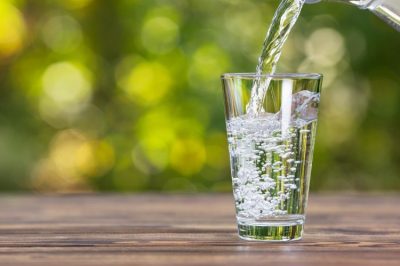Water

Don’t Drink The Water
Modern agriculture destroys environments largely because it takes so much food to feed animals. The raising of animals for meat or dairy products is, without doubt, the most damaging effect of our modern diet. These animals need massive amounts of precious, scarce food and water. The average water footprint of beef is 15,400 litres per kilo of meat globally. The water is primarily used to grow the feed. So every pound of beef costs the planet 7,000 L (1,800 gal.) of water. I wonder if it would make a difference if everyone who saw a steak was aware of the resources it represents. The World Business Council for Sustainable Development observes:
“Fifty years ago, it was thought that water was an infinite resource. At that time, there was fewer than half the current number of people on the planet. People consumed fewer calories and ate less meat, so less water was needed to produce their food. The volume of water was about a third of what we use today. With a population of over seven billion, the consumption of water-thirsty meat increases competition for this resource. Even more water will be needed to produce food in the future because the Earth’s population is forecast to rise to nine billion by 2050. It is estimated that 70 percent of worldwide water is used for irrigation, with 15 percent–35 percent of irrigation withdrawals being unsustainable.
According to Professor Frank Rijsberman (chairman of the Challenge Program on Water and Food Consortium):
“If present trends continue, the livelihoods of one-third of the world’s population will be affected by water scarcity by 2025. We could be facing annual losses equivalent to the entire grain crops of India and the US combined. The crisis has to be addressed comprehensively at all levels, from the way farmers use water to international policy decisions that affect reforms and investments in water management and infrastructure.”
Every Drop Counts
The concept of “virtual water” is used to show a product’s impact on water resources worldwide, an estimate of the amount of water “embodied” in the product through its production. Virtual water, when applied to food products, shows the dramatic effect of meat production. Incredibly, beef cattle account for 62.7 percent of water used globally, and dairy cows convert 12.1 percent. Beef uses approximately ten times more water than wheat.
Conventional agriculture not only kills the soil, it infects the waterways and oceans. Chemical runoff pollutes waterways and kills life in lakes and rivers. Eventually, this toxic broth will make its way to the sea, creating “dead zones.” These are areas where the nitrites promote eutrophication, causing algal blooms which ultimately lead to depleted oxygen levels and generally poor water quality. There are now over four hundred of these dead zones—where nothing except algae survive—in the oceans of the world. These dead zones and other forms of ocean pollution also kill the phytoplankton. These tiny organisms float on the surface of the oceans and contribute more oxygen than the rainforests of the world.
About 97 percent of the water on the planet is in the oceans; 2.5 percent is fresh water that is frozen, and only 0.05 percent of the world’s water is available for drinking. Agriculture is the main pollutant of groundwater, aquifers, lakes, reservoirs, and rivers. Oil, degreasing agents, metals, and toxins from farm equipment often end up in drinking water. So does manure. Waste and ammonia then turn into nitrate that reduces oxygen and kills many aquatic animals.
We need clean water to support healthy agricultural practice and for human consumption, both direct and indirect. A future where clean water is seen only as a product to be marketed has already arrived. When we consider that water is a primary nutrient, our disregard of the quality of municipal water supplies amounts to criminal neglect.
The American Society of Civil Engineers (ASCE) gave US drinking-water infrastructure a D grade in their 2017 report. Among the problems contributing to this poor rating were old pipes that were prone to break, significant leakage, and allowing pathogens to penetrate the system. Often, all these problems were evident in the same system. They cited from between six million and ten million lead service lines in the US leading to lead-contaminated drinking water. Even low levels of lead contamination can lead to damage to the central nervous system in children, learning disabilities, impaired hearing, and difficulty in forming blood cells. In adults, elevated levels contribute to miscarriages and stillbirths, fertility problems, cognitive dysfunction, and elevated blood pressure in healthy adults.
Poisoning the Well
Since its inception in 1970, the Environmental Protection Agency has fought an uphill battle with local and state governments and industry to establish and enforce the Clean Drinking Water Act (SDWA). Every small victory has been offset by increased pollution by industry and social indifference. It is only when the problem becomes intolerable that action is considered. As usual, it is often the poorest communities that suffer the most. Around 95 percent of the population of Puerto Rico are drinking water that is in violation of the SDWA regulations.
In 2015, there were over 12,000 SDWA violations reported from 5,000 community water systems in America. These violations affected over 27 million people (one out of every twelve). These violations included pollution by disinfection by products, coliform bacteria, surface and groundwater pathogens, nitrate and nitrite levels exceeding safe exposure, and unsafe lead and copper levels.
If soil is the digestive function of planet Earth, then the oceans, rivers, and streams are the circulatory system. We have blocked the arteries of the Earth and created toxic and anemic blood. As CO2 increases its concentration in the oceans, it causes higher acidity. This rapid change disrupts sea life, creating decay of coral reefs and dissolving the shells of many species of sea creatures. The impact of this on the future of all life in the oceans would be breaking down the intricate food chain.


